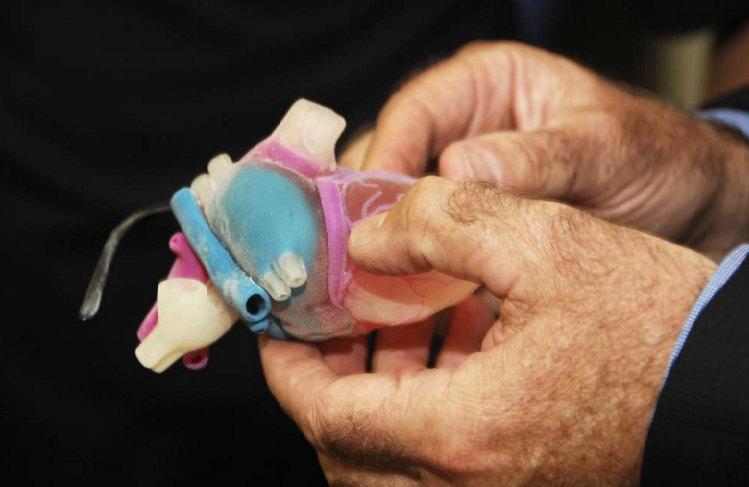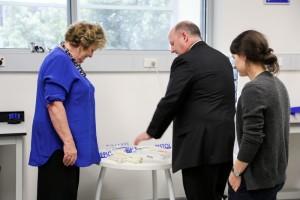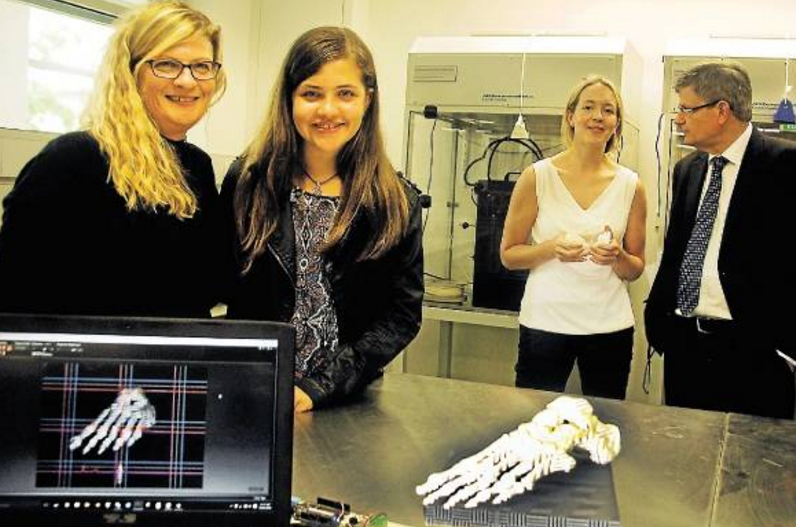 It’s safe to say that most people, unless they have a passion for technology and all that comes with it, still have a fairly topical view of 3D printing. Colorful and sometimes derisive comments still abound, however, trivializing the 3D printer’s use as a desktop manufacturer of red plastic keychains and tiny figurines for which gamers often show an affinity. It doesn’t take much reading these days though to quickly see that 3D printing isn’t going anywhere–and it’s the main reason that a number of individuals are moving forward like they never thought they would, thanks to a wide range of prosthetics, implants and more.
It’s safe to say that most people, unless they have a passion for technology and all that comes with it, still have a fairly topical view of 3D printing. Colorful and sometimes derisive comments still abound, however, trivializing the 3D printer’s use as a desktop manufacturer of red plastic keychains and tiny figurines for which gamers often show an affinity. It doesn’t take much reading these days though to quickly see that 3D printing isn’t going anywhere–and it’s the main reason that a number of individuals are moving forward like they never thought they would, thanks to a wide range of prosthetics, implants and more.
While we love to hear stories about anyone’s quality of life being elevated due to a medical challenge, there’s just something incredibly inspiring about seeing children being helped–especially the ones who have so bravely adjusted to their disabilities and never imagined the day that a 3D printer would come along and change life as they know it. We’ve seen this countless times now, but never without awe–as volunteer organizations like e-NABLE continue to provide new prosthetic designs for kids, to specialists overseas engaging in restoring use to a young boy’s arm thanks to a 3D printed implant.
Now in Australia, the EPIC 3D Orthopaedic Lab has just been unveiled at The Children’s Hospital at Westmead–EPIC stands for Engineering and Prototyping Implants for Children. The refurbished laboratory is designed to give children a new lease on life through 3D printed implants, aimed specifically at those with lower limb deformities. As is so often the case with 3D printing in the medical sector, its benefits are substantial in that an item like an implant can be completely customized to the individual.Medical personnel involved in the project see this lab as completely revolutionizing implants, as they tailor them to younger kids–where a one-size-fits-all concept certainly doesn’t ‘fit.’
Their first 3D printed implant will actually be launched on the market this year via the lab, which is funded by the Australian government.“A multi-disciplinary team of surgeons, engineers, biomedical scientists and allied health professionals work on the design and development on-site, consulting with manufacturers, both local and global, to refine the designs,” the hospital’s website explains. “The NSW Government funded the refurbishment of the laboratory and has helped bring an innovative medical technology to market through the NSW Medical Devices Fund. A donation from Hyundai Help for Kids funded the purchase of two 3D printers. Donated funds also enable two engineers to work on the projects for two years.”
“We have six innovative devices in varying stages of development for commercialization, with a view to exporting them globally,” says Children’s orthopaedic surgeon Professor David Little.
One patient so far has benefited greatly from one of the 3D printed implants: Tiana Stalley suffers from a type of neurofibromatosis which is better known as NF1. Diagnosed as a baby, she went through ten surgeries and–needless to say–a lot of challenge physically.
A special surgery made all the difference for Tiana, finally, when doctors inserted a metal implant in her leg, running from the knee to the ankle, and designed to grow as she grows.“She was isolated to the school library at recess and lunchtimes,” her mother, Nicole, said. “Making friends was very hard. She wasn’t invited to kids’ houses and couldn’t play sports.”
“The opening of the EPIC clinic is an exciting development for children with NF1 bone disorder issues,” says her mother.
The implant straightened her leg and changed her life, allowing her to become active, and as her mother says, able to “be a normal teenage girl.”
Current implant technology has a very high failure rate, which only causes more challenge for those who are disabled. It’s hoped that with the opening of this lab many other children will have similar results–and begin to enjoy an improved quality of life similar to Tiana’s. Do you know anyone currently benefiting from a 3D printed implant? Share your thoughts with us in the EPIC 3D Implant Lab forum over at 3DPB.com.
Subscribe to Our Email Newsletter
Stay up-to-date on all the latest news from the 3D printing industry and receive information and offers from third party vendors.
You May Also Like
Precision at the Microscale: UK Researchers Advance Medical Devices with BMF’s 3D Printing Tech
University of Nottingham researchers are using Boston Micro Fabrication‘s (BMF) 3D printing technology to develop medical devices that improve compatibility with human tissue. Funded by a UK grant, this project...
3D Printing Webinar and Event Roundup: April 21, 2024
It’s another busy week of webinars and events, starting with Hannover Messe in Germany and continuing with Metalcasting Congress, Chinaplas, TechBlick’s Innovation Festival, and more. Stratasys continues its advanced training...
3D Printing Webinar and Event Roundup: March 17, 2024
It’s another busy week of webinars and events, including SALMED 2024 and AM Forum in Berlin. Stratasys continues its in-person training and is offering two webinars, ASTM is holding a...
3D Printed Micro Antenna is 15% Smaller and 6X Lighter
Horizon Microtechnologies has achieved success in creating a high-frequency D-Band horn antenna through micro 3D printing. However, this achievement did not rely solely on 3D printing; it involved a combination...
































